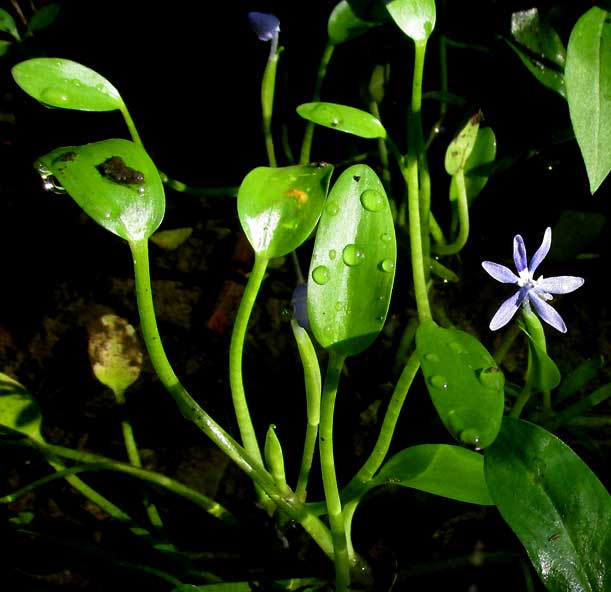Excerpts from Jim Conrad's
Naturalist Newsletter

from the November 22, 2015 Newsletter issued from Hacienda Chichen Resort beside Chichén Itzá Ruins, central Yucatán, MÉXICO
MUDPLANTAIN
We last saw Mudplantain, also known as Ducksalad, HETERANTHERA LIMOSA, in a big mud puddle at the edge of a cotton field in southwestern Mississippi, in June of 2012. The puddle was regularly slogged through by big machinery, and I was amazed that such a fragile-looking, elegant little waterplant as the Mudplantain could survive such abuse. You can see a beat-up but flowering plant soon after the passage of a tractor through its puddle at www.backyardnature.net/n/h/mudplant.htm.
On that page I write that Mudplantain's orchid-like blossoms can be either white or blue, and you can see that our Mississippi Mudplantain's flowers were white. This week a car-sized population of blue-flowered ones turned up in a shallow puddle on a seldom-used trail through the woods here at Hacienda Chichen. Atop this page you can see some of the ankle-high plants, with early morning dew beading on their waxy leaves.
A close-up of a slightly asymmetrical Mudplantain flower with three stamens of two lengths is shown below:

Mudplantains occur from the southern US south through all of Latin America into Brazil and Argentina, so it's not surprising to find them here. However, I was a little surprised that once again they turn up where they're likely to be disturbed by occasional traffic. However, now I read that though Mudplantains are considered a threatened species in parts of the central US, in California they're regarded as invasive weeds making a nuisance of themselves in rice paddies.
It's also surprising that what is essentially an aquatic plant makes it into this arid part of Mexico were each year water pools in depressions only for a few weeks at the end of the wet season. Most of the year the trail these plants occupy is free of water, or at most a little muddy after rains. Mudplantain is an annual, and it's clear that once it has water it can grow fast.
The online Flora of North America states that Mudplantain flowers open within one hour after dawn, but wilt by midday. At 8:30 AM, most of the ones in our Hacienda puddle already were wilted and I had to look around for fresh ones. The Wikipedia author for the species reports that the flowers can be ground into a paste that soothes wounds and burns, like Aloe Vera juice.